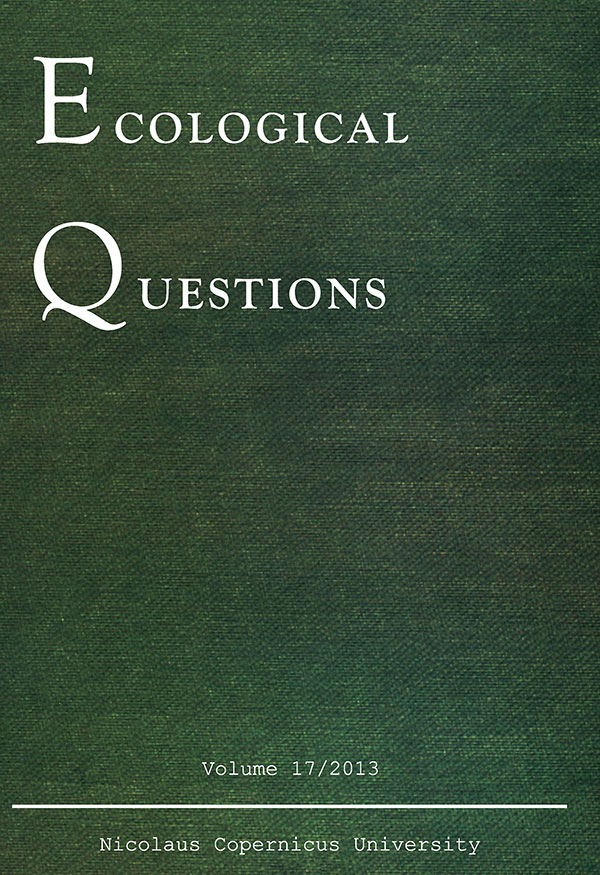Indicators of landscape diversity derived from remote sensing based land cover maps – spatial and thematic aspects
DOI:
https://doi.org/10.12775/ecoq-2013-0021Keywords
landscape indicators, land cover classifications, landscape fragmentationAbstract
Landscape is heterogeneous part of the Earth surface, forming mosaic of various habitats organized at different scales and levels (Johnson et al. 1992). The landscape pattern has important impact on ecological processes; hence its analysis through quantitative measures is essential for environmental studies. There are many indicators characterizing spatial structure of landscape at different level of detail; they enable analysis of landscape fragmentation at patch level, through studies at habitat level up to complex analyses at landscape level. Seven indicators, which are related to various levels of detail, were selected at the presented work. The following indicators have been studied: Patch Density, Edge Density, Patch Richness, Simpson Diversity Index, Natural Patch Richness, Percentage of Natural Landscape, Mean Natural Patch Area (McGarigal & Marks 1995). First two indicators were used for analysis of landscape fragmentation at patch level, next two at land cover level, while the last three were applied for studies of natural and semi-natural classes at both levels. The studies were performed at six test areas located in different regions of Europe (France, Germany, Poland, Latvia, Spain and Italy), using two different land cover maps. First map was based on Very High Resolution (VHR) Kompsat satellite images (4 m spatial resolution); it included 8 land cover categories with 0.25 ha Minimum Mapping Unit (MMU). CORINE Land Cover (CLC) map 2006 (25 ha MMU) was the second map used for analyses. Number of land cover classes in case of CLC map varied from 9 for Poland till 14 for France. All above mentioned indicators were calculated for grids with 100, 200, 500 and 1000 meter cell size, corresponding to 1, 4, 25 and 100 ha, respectively. The obtained results reveal high usefulness of land cover maps based on VHR satellite images for analysis of landscape fragmentation, even for grids with 100 m cell size. It was found that at patch level these materials are superior to CLC classifications, irrespective of cell area. In case of land cover level VHR data are better while using 100 and 200 m grid cells, whereas for larger cell sizes – 500 and 1000 m – results are not so evident, depending on degree of landscape fragmentation and spatial structure characteristic for individual land cover classes.
References
Baker W. L., & Cai Y., 1992, The r le programs for multiscale analysis of landscape structure using the GRASS geographical information system, Landscape Ecology 7: 291–302. DOI 10.1007/BF00131258
Gardner R. H., R. V., O’Neill R.V. & Turner M. G., 1993, Ecological implications of landscape fragmentation, Pages 208–226, [in:] S. T. A. Pickett & M. G. Mc- Donnell (eds.) Humans as components of ecosystems: subtle human effects and ecology of population areas, Springer-Verlag, New York. DOI 10.1007/978-1-4612-0905-8_17
http://www.eea.europa.eu/data-and-maps/data/clc-2006- vector-data-version-2.
http://www.umass.edu/landeco/research/fragstats/fragstats.html.
Gimona A., Messager P., Occhi M., 2009, CORINE-based landscape indices weakly correlate with plant species richness in a northern European landscape transect, Landscape Ecology (2009) 24: 53–64. DOI 10.1007/s10980-008-9279-7
Gulinck H., Múgica M., Vicente de Lucio J., Atauri J.A., 2001, A framework for comparative landscape analysis and evaluation based on land cover data, with an application in the Madrid region (Spain), Landscape and Urban Planning 55: 257–270. http://dx.doi.org/10.1016/S0169-2046(01)00159-1
Johnson A. R., Wiens J. A., Milne B. T. & Crist T. O., 1992, Animal movements and population dynamics in heterogeneous landscapes, Landscape Ecology 7: 63–75. DOI 10.1007/BF02573958
Lewiński S., Bochenek Z. & Turlej K., 2010, Application of object-oriented method for classification of VHR satellite images using rule-based approach, Geoinformation Issues 2 (1) 19–26. DOI 10.1007/978-94-007-7969-3_12
Lewiński S., Bochenek Z. & Turlej K., 2011, Object-oriented method for land cover mapping using VHR satellite images based on decision-tree approach and texture information, 4th EARSeL SIG Workshop on Remote Sensing of Land Use & Land Cover.
McGarigal K. & Marks B. J., 1995, FRAGSTATS: spatial pattern analysis program for quantifying landscape structure, Gen. Tech. Report PNW-GTR-351, USDA Forest Service, Pacific Northwest Research Station, Portland, OR.
O’Neill R. V., Krummel J. R., Gardner R. H., Sugihara G., Jackson B., DeAngelis D. L., Milne B. T, Turner M. G., Zygmunt B., Christensen S. W., Dale V. H, & Graham R. L., 1988, Indices of landscape pattern, Landscape Ecology 1: 153–162. DOI 10.1007/BF00162741
Schmit C., Rounsevell M. D. A., La Jeunesse L., 2006, The limitations of spatial land use data in environmental analysis, Environmental Science & Policy 9: 174–188. http://dx.doi.org/10.1016/j.envsci.2005.11.006
Smith G., Ziółkowski D., Kotarba A., Turlej K., Bochenek Z., Lewiński S. & Dąbrowska-Zielińska K., 2012, Indicators of environmental diversity derived from generic land cover products based on VHR satellite images, Technical Report.
Tormos T., Kosuth P., Durrieu S., Villeneuve B., Wasson J. G, 2011, Improving the quantification of land cover pressure on stream ecological status at the riparian scale using High Spatial Resolution Imagery, Physics and Chemistry of the Earth 36: 549–559. http://dx.doi.org/10.1016/j.pce.2010.07.012
Turner M. G., 1990, Spatial and temporal analysis of landscape patterns, Landscape Ecology 4: 21–30. DOI 10.1007/BF02573948
Turner M. G., &. Gardner R. H, (eds.), 1991, Quantitative methods in landscape ecology. Springer-Verlag, New York. http://dx.doi.org/10.1007/978-1-4757-4244-2
Uuemaa E., Juri Roosaare J., Ulo Mander U., 2005, Scale dependence of landscape metrics and their indicatory, value for nutrient and organic matter losses from catchments, Ecological Indicators 5: 350–369. http://dx.doi.org/10.1016/j.ecolind.2005.03.009
With K. A., 1999, Is landscape connectivity necessary and sufficient for wildlife management?, [in:] J. A. Rochelle, L. A. Lehmann & J. Wisniewski (eds.) Forest fragmentation: wildlife and management implications, Brill, The Netherlands, 97–115.
Wu J., Shen W., Sun W., Tueller P.T., 2002. Empirical patterns of the effects of changing scale on landscape metrics. Landscape Ecology 17 (8): 761–782.
Downloads
Published
How to Cite
Issue
Section
Stats
Number of views and downloads: 705
Number of citations: 0



